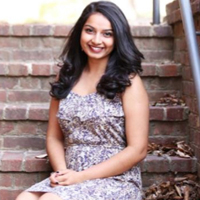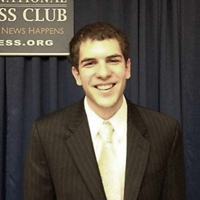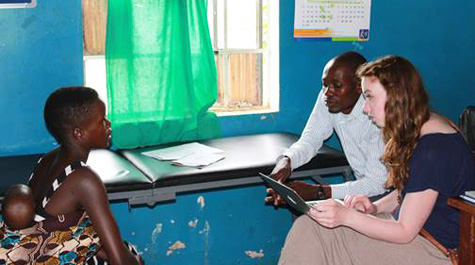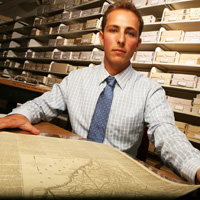4 students working as HESN summer interns
Four William & Mary students are participating in the Higher Education Solutions Network (HESN) summer internship program, working at the U.S. Global Development Lab and throughout the U.S. Agency for International Development (USAID).
Overall, 16 students were selected from five HESN labs – W&M, Texas A&M, Duke, UC Berkeley and the Massachusetts Institute of Technology – and were assigned to various bureaus at USAID/Washington.
Nairuti Shastry ’17, graduate student Rob Marty, Fletcher Souba '15 and Alison Roberts '15 were chosen.
Shastry, a sociology and French & Francophone studies major, is working with the office of HIV/AIDS. She is a monitoring and evaluation intern on the “Orphans and Vulnerable Children” team, working on an implementation guide for the team’s monitoring systems.
The guide will help USAID’s foreign service officers working in countries where programs designed to prevent AIDS among orphans and vulnerable children are already in place.
“It's really interesting work because I get to focus on the second part of development: monitoring and evaluation of the projects,” she said. “This is vital to understanding why certain projects work or don’t work and taking proactive measures to change negative outcomes.”
Recently, Shastry attended the United Nations AIDS Inter-Agency Task Team symposium, also known as “Good Quality Education for Adolescent Girls for an AIDS-Free Future.”
There, she listened to speeches and interacted with international development representatives from Indonesia, Zambia, Jamaica, Save the Children, UNESCO, the U.N. Girls Education Initiative and the International Labor Organization.
Marty is a master’s student at the university, pursuing a joint degree in public policy and operations research. He is working with the office of economic policy, where his job is two-fold. One, he is helping to develop and teach a course on cost-effectiveness analysis in health, primarily to global health officers. Two, he and the chief economist are looking at how financial flows within developing countries have evolved over the past decade.
"A lot of what the Office of Economic Policy does is to help integrate economic analysis into USAID’s work, where one of the ways they do this is to teach courses to different offices at USAID," he said. "We’re teaching the course primarily to global health officers, and they have remarked how the type of analysis we’re teaching will be especially useful in guiding decision making. It's been neat to see them discuss details of the work they do, and get specific about how the type of analysis we’re teaching will be useful to them. It's also been a neat opportunity to see how different offices work together, and to see efforts within USAID to ensure data is used to better guide decision-making."
USAID's sustainable development goals  are due for re-endorsement in September, Marty said, which has generated discussion among the international community about financing the post-2015 development agenda.
are due for re-endorsement in September, Marty said, which has generated discussion among the international community about financing the post-2015 development agenda.
"To this end, we’re looking at how the relative role of different types of finances -- foreign aid, remittances, domestic taxes and private flows -- has changed," he said. "Ideally, better understanding the sources of financial flows will help to ensure they’re harnessed most effectively to support development efforts."
Roberts graduated with a bachelor’s degree in biology and government. She has been assigned to the global partnerships office, where she has been working on analyzing and visualizing data on USAID's active public-private partnerships. Her analysis will be used by the team in its future work with potential outside partners.
“I've created lasting data visualizations the team can use to explain their mission and results to other parts of USAID and the U.S. government," she said. "It's really exciting to be leaving a concrete product behind for them.By applying my visualization skills in an office setting, I've learned to really focus on what the user needs. I could make a bunch of really cool maps for this team, but if they weren't saying anything really useful, they wouldn't get used long term."
During her four years at W&M, Roberts was a research assistant in the Public Health Nutrition Lab, where she completed her honors thesis on the link between the empowerment of women and child nutrition.
Roberts’ interest in partnerships was born out of her work with W&M’s Students Organizing for Medical Outreach and Sustainability (SOMOS).The organization partners with a community in the Dominican Republic to build infrastructure that helps the people there tackle problems of poverty and health.
Souba is working with the policy team within the Bureau for Food Security. The team covers a range of topics related to food security and ending extreme poverty, including climate smart agriculture, trade, nutrition, risk and resilience and gender. Souba’s work has touched on most of these topics, with emphasis on agriculture and trade.
He began the summer conducting research and forming a bureau-wide database on the toxic fungus aflatoxin, which has a disastrous effect on crops like maize and groundnuts in Africa and causes liver cancer, suppresses the immune system and stunts the growth and development of children.
Lately, he has begun research on USAID’s 2004 Strategy on Trade Capacity Building. His initial role was to dissect the old strategy and present the core elements to senior trade analysts within the Economic Growth, Education, and Environment Bureau. Souba is also working to help restructure the document, with specific emphasis on increasing the trade and agricultural language within it.
“It has been beneficial to see the inner workings of one of the largest aid donor organizations in the world,” he said. “While still misty, I understand that USAID’s functions are incredibly complex. USAID is positioned in between Congress and the American people, country missions, implementing partners and the billions of effected individuals throughout the world.
“In an effort to actually create beneficial change, work must be conducted efficiently as well as organized and aligned with other donor agencies and partners so that efforts are not unnecessarily duplicated, but complementary to the system. Finally, USAID in Washington, D.C. operates at a very high altitude, and it is important to stay focused on the progress and development from the field offices on the ground level.”
Once the internship is over, Souba will spend nine months in Rwanda as a Health Gardens International Fellow. The NGO partners with health centers throughout the state to alleviate the malnutrition issue that is prevalent among the nation’s poor and vulnerable.
“A strong aspect of this fellowship will involve the bridging of health and nutrition, agriculture and data analysis,” he said, “which the USAID HESN internship program has strongly prepared me for.”
















